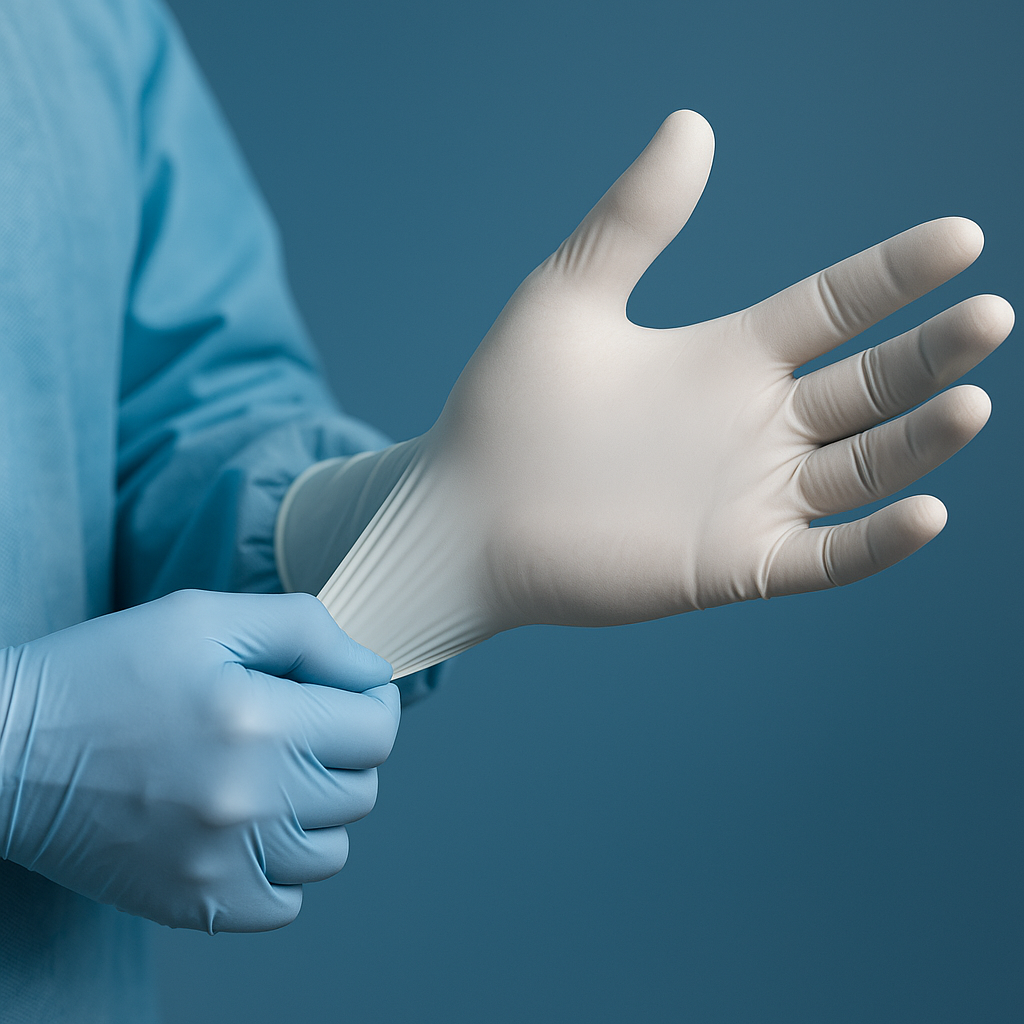In the high-stakes environment of modern medicine, surgical gloves play a critical—and often underappreciated—role. They are not merely protective gear, but an extension of a surgeon’s hands: enabling precision, safeguarding lives, and preventing cross-contamination. In this comprehensive guide, we dive deep into what makes high-quality surgical gloves, the science behind various materials, practical advice for selection and use, and the future of glove technology.
Why Surgical Gloves Matter
Surgical gloves are a vital component of infection control in clinical settings. Their primary purpose is to act as a sterile barrier between healthcare professionals and patients, preventing the transfer of bloodborne pathogens, bacteria, viruses, and other contaminants. U.S. Food and Drug Administration+2Eastwest Medico+2
However, the stakes are higher in surgery than in routine examinations. In surgical contexts, gloves must maintain integrity during prolonged procedures, resist puncture, allow tactile sensitivity, and support ergonomics. A glove failure during surgery can have catastrophic consequences.
Moreover, authorities like the FDA regulate surgical gloves more stringently than standard medical gloves, enforcing standards for leak resistance, strength, biocompatibility, and sterility. U.S. Food and Drug Administration
Key Features of High-Quality Surgical Gloves
When evaluating surgical gloves, these are the features that distinguish excellence from mediocrity:
- Barrier integrity & puncture resistance
A glove must resist tears, micro-perforations, and breaches—even under stress. A high tensile strength and tear resistance help maintain sterility during the most demanding maneuvers. usamedicalsurgical.com+2PMC+2 - Dexterity, tactile sensitivity & fit
Surgeons need to feel subtle tissue textures, handle microsutures, and make fine adjustments. A snug yet comfortable fit, minimal interference with movement, and tactile feedback are vital. medline.com+3S2S Global+3PMC+3 - Ergonomics & hand fatigue reduction
Poorly designed gloves can lead to hand cramping, fatigue, or loss of precision in long operations. Ergonomic shaping, proper finger curvature, and material flexibility help reduce strain. S2S Global+1 - Grip & texture
Wet or slippery conditions are common in surgery. Micro-textured or patterned glove surfaces help maintain a secure grip on instruments, reducing slippage risk. products.halyardhealth.com+2medline.com+2 - Powder-free & hypoallergenic
Powder used to aid donning has been linked to complications like granuloma formation, inflammation, or tissue irritation. Hence, most surgical gloves today are powder-free. U.S. Food and Drug Administration+1
Additionally, latex allergies affect many patients and staff; thus non-latex materials (nitrile, neoprene, polyisoprene) are important alternatives. PMC+3U.S. Food and Drug Administration+3Gloves.com+3 - Sterility assurance & manufacturing control
Each glove must be individually packaged, sterilized, and handled in a way that ensures it remains sterile until use. Stringent quality control and certification (ISO, ASTM, FDA) are mandatory. U.S. Food and Drug Administration+2PMC+2 - Durability over time & shelf life
A glove should stay stable (no degradation) over its shelf life under proper storage conditions. Packaging, material choice, and manufacturing processes all affect longevity. PMC - Compatibility with chemicals & sterilants
Some surgeries involve exposure to disinfectants, chemotherapy agents, or other chemicals. Gloves rated for chemical resistance (e.g. ASTM D6978) are essential in such settings. medcart.com.au+2products.halyardhealth.com+2
Materials & Types of Surgical Gloves
Surgical gloves are manufactured from several core materials; each comes with advantages and trade-offs. Understanding these helps you match glove types to use cases.
| Material | Strengths / Benefits | Limitations / Considerations |
|---|---|---|
| Latex (natural rubber) | Excellent elasticity, natural feel, sensitivity, proven track record. | Risk of latex allergy; protein content must be carefully managed. U.S. Food and Drug Administration+3medcart.com.au+3PMC+3 |
| Nitrile | Great puncture/tear resistance, chemical resistance, hypoallergenic. | Slightly less tactile sensitivity (though modern formulations are strong). PMC+3Gloves.com+3medcart.com.au+3 |
| Neoprene / Polychloroprene | Offers a good balance: elasticity, chemical resistance, fewer allergens. S2S Global+3S2S Global+3medcart.com.au+3 | May cost more and may not match the tactile feel of latex. |
| Polyisoprene | Closest synthetic alternative to latex sensation without latex proteins. | Costlier; might have lower abrasion resistance. |
| Vinyl / PVC | Low-cost option for low-risk procedures. | Lower flexibility, lower barrier protection; generally not recommended for high-risk surgical tasks. preferredmedical.com+1 |
There is also the difference between sterile surgical gloves and non-sterile medical/examination gloves. Surgical gloves are always sterile, individually packaged, and manufactured to tighter tolerances. Wikipedia+2Gloves.com+2
Within surgical gloves, subdivisions exist by specialty demand: general surgery, microsurgery, orthopaedic, laparoscopic, and double-gloving systems, each with variations in thickness, cuff length, flexibility, and strength. medcart.com.au+3INTCO Medical+3S2S Global+3
For example, microsurgery gloves aim to maximize tactile sensitivity (thinner walls), whereas gloves for orthopedic or trauma work might emphasize robustness under stress. INTCO Medical+1
Selecting the Right Surgical Gloves for Your Use Case
When choosing surgical gloves for your facility or lineup, consider a strategic combination of performance metrics, cost, and user preferences.
1. Risk level of procedure
For high-risk or long-duration surgeries, prioritize gloves with high puncture strength, chemical/sterility certifications, and durability. Lower-risk or shorter procedures might allow lighter gloves.
2. Allergy concerns
If staff or patient allergy to latex is a concern, choose nitrile, neoprene, or polyisoprene surgical gloves. Always verify that the glove is truly latex-free and meets equivalent barrier performance.
3. Grip preferences & tactile feel
Surgeons may prefer micro-texture surfaces for grip in wet fields. If they need high tactile sensitivity (e.g. nerve or vascular surgery), thinner, more flexible gloves are useful.
4. Donning ease & cuff style
Beaded cuffs, special internal coatings or chlorination help with ease of donning, especially in glove changes during surgery. Gloves with long cuffs or integrated sleeves are useful in decontamination or OR turnover contexts. Aorn.org
5. Double-gloving strategies
Double-gloving—wearing two layers—is commonly used to reduce risk of inner-layer perforation. Some glove systems use contrasting colors (e.g. blue outer, white inner) to help detect breaches. Cetrix Technologies LLC+3S2S Global+3PMC+3
6. Standards & certifications
Ensure gloves comply with relevant standards (ISO, ASTM, or local health authority). For chemical handling (e.g. chemo), check for specific certifications like ASTM D6978. medcart.com.au+2PMC+2
7. Cost vs performance trade-off
Though high-end gloves cost more, selecting gloves that reduce tear rates, reduce wastage, and improve outcomes can lower overall cost per procedure. Bulk procurement and supplier reliability also matter.
Best Practices for Use & Safety
Even the best surgical glove can fail if misused. Here are vital guidelines:
- Proper hand hygiene before donning: Wash hands or use approved hand rub, then dry thoroughly.
- Inspection upon donning: Check for defects or pinholes before use.
- Change gloves periodically: Studies show perforation risk increases after ~90 minutes. Change at intervals or on visible compromise. Eastwest Medico+3medcart.com.au+3Gloves.com+3
- Don’t reuse gloves: They are disposable. Reusing or disinfecting gloves is unsafe. U.S. Food and Drug Administration+1
- Double-gloving in high-risk settings: Helps detect outer glove breaches and offers extra protection. S2S Global+2PMC+2
- Safe removal techniques: Use proper glove removal technique to avoid self-contamination.
- Proper disposal protocols: Treat used surgical gloves as medical waste, dispose per biohazard controls.
- Storage & handling: Keep gloves in cool, dry conditions; avoid UV and ozone exposure which degrade material.
Common Challenges & How to Overcome Them
- Latex allergies: Shift to high-quality non-latex alternatives and educate staff.
- Frequent glove tearing: Reevaluate glove strength, fit, and handling. Use reinforced models for critical tasks.
- Donning difficulty: Use chlorinated or silicone-coated gloves; ensure proper sizing.
- Cost concerns: Negotiate volume discounts, analyze lifecycle cost (fewer tears, less waste), and use tiered glove inventory (premium for critical surgery, lower for less-demanding tasks).
- Supply chain disruptions: Partner with reliable manufacturers, keep buffer stock, diversify suppliers.
Trends & Innovations in Surgical Glove Technology
The surgical glove industry continues to evolve. Some noteworthy trends:
- Ultra-thin, high-strength materials: New polymers and manufacturing methods push the envelope of thickness vs strength.
- Smart gloves / sensor integration: Research is underway on gloves incorporating sensors to monitor pressure, slippage, or glove integrity.
- Sustainable / biodegradable materials: As environmental concerns rise, greener materials and production methods are being explored.
- Custom and branded gloves: Hospitals or groups may order gloves with custom branding, color-coding, or specialized fit. INTCO Medical
- Advanced ergonomic shaping: More anatomically contoured gloves reduce fatigue. S2S Global+1
Why NatalIe Group’s Surgical Glove Offering Should Stand Out
Given the competitive landscape, here’s how NatalIe Group can ensure your surgical glove line or offering is compelling:
- Emphasize superior barrier and puncture metrics — publish test data or certifications.
- Highlight comfort, ergonomics & tactile sensitivity — use surgeon testimonials, comparative demos.
- Offer latex-free / allergy-safe options — addressing a critical pain point.
- Provide double-glove systems / color contrast models — for added safety and breach detection.
- Offer custom branding or color options — for client differentiation.
- Show work on sustainable sourcing / manufacturing — a differentiator in modern procurement.
- Educate through content — Make blogs, whitepapers, training videos about best glove practices.
- Reliable supply chain & regulatory compliance — transparency in certifications, audits, traceability.
Conclusion
Surgical gloves are far more than a disposable accessory—they are a surgeon’s literal second skin, critical to patient safety, infection control, and surgical success. Choosing the right glove involves balancing material science, ergonomics, risk factors, and cost.
For NatalIe Group, positioning your surgical glove offering as high-performance, safe, customizable, and backed by clinical data will help you stand out. Use education (like this blog), certifications, customer testimonials, and performance data to build trust and drive adoption among healthcare professionals.

